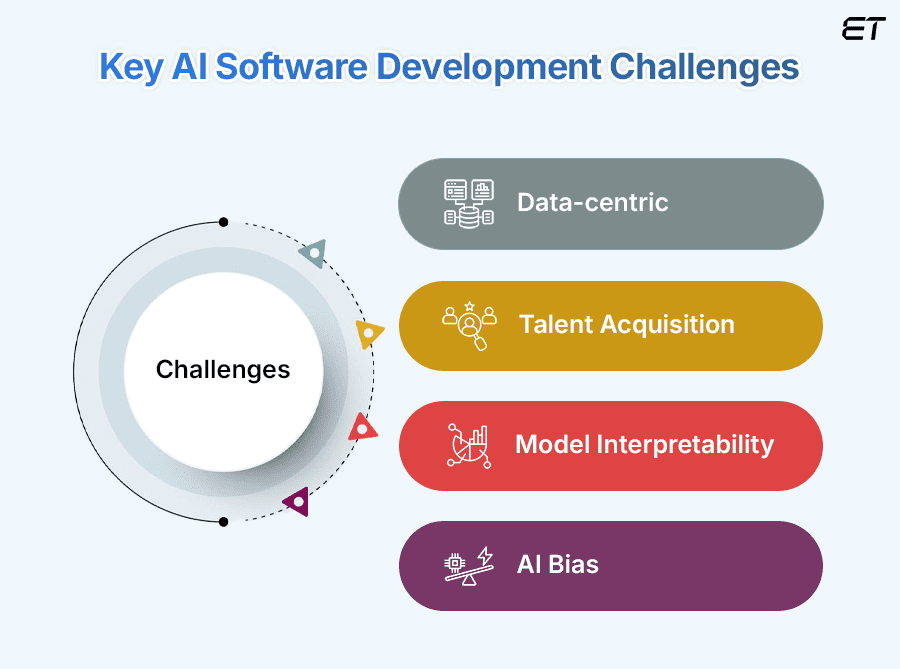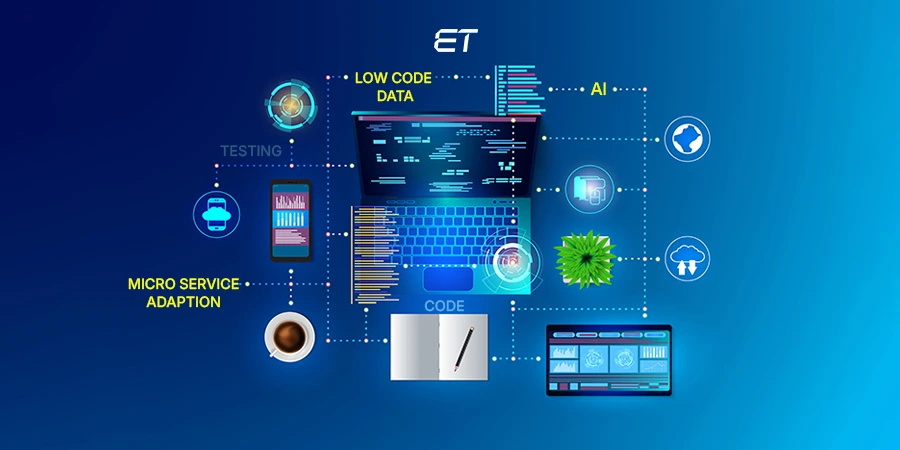
How to Build AI Software: Manual for CTOs
As a CTO, you are your organization’s strategic visionary. By using sound leadership strategies, you can utilize AI software and make it a worthy asset for your workplace.
Get this – the AI market can surpass a staggering USD 826 billion mark in 2030. So, to leverage this booming sector, you need to know how to make AI that aligns with your business objectives.
The truth, however, is that building AI applications is not a piece of cake. You need to follow a methodical process that combines the data-driven and human-centric approach. In this blog, we have explained the steps to build AI software and included vital information that can guide you profoundly.
Understanding the AI Landscape

The AI (artificial intelligence) landscape undergoes continuous changes. For CTOs, navigating this territory requires a clear understanding of the technology, its potential applications, and the challenges it presents.
At its core, artificial intelligence can perform tasks requiring human intelligence. Machine learning (ML), a subset of AI, empowers systems to learn from data without explicit programming. So, you can use ML to build AI software that delivers exceptional results compared to conventional counterparts.
On the other hand, deep learning, a specialized form of ML, uses neural networks to model complex patterns. As a CTO, you should be aware of these terms to understand the approach and elements of a potential AI software development company.
Need quick assistance for your AI project?
How AI Catalyzes Your Business?
In simple terms, AI optimizes your operations to create entirely new products. It also offers several use cases as follows:
- Manufacturing: Predictive maintenance, quality control, supply chain optimization
- Healthcare: Drug discovery, personalized medicine, medical image analysis
- Finance: Fraud detection, algorithmic trading, risk assessment
- Retail: Personalized recommendations, inventory management, customer service
So, by identifying potential AI software applications within your organization, you can unlock new areas for growth and efficiency.
Building a Strong AI Foundation

To create well-functioning AI software, you need to set a solid foundation. Your artificial intelligence strategy should encompass the following elements:
- Data
- Talent
- Infrastructure
- Ethics
In this section, we will explain each component in brief.
1. Data

Data is the fuel that powers AI models. To build a strong foundation, CTOs like you must prioritize data quality, accessibility, and governance:
- Data Quality: Ensure data accuracy, consistency, and completeness
- Data Accessibility: Create centralized data repositories and establish data governance policies to ensure easy access for AI teams
- Data Privacy and Security: Protect sensitive data through robust security measures and compliance with data privacy regulations (e.g., GDPR, CCPA)
Overall, by ensuring the accuracy and storage of data, you can proceed with the steps to build AI software confidently.
2. Talent

Building a world-class AI software development team is essential for driving innovation. You can follow these steps to acquire the most talented team:
- Acquisition: Identify and recruit AI experts with diverse skill sets, including data scientists, machine learning engineers, and AI researchers
- Development: Invest in employee training and development programs for continuous learning and upskilling
- Collaboration: Encourage cross-functional collaboration between AI teams and business
These days, you can partner with an IT company that provides AI software development services. This approach eliminates the need to find, hire, and organize a skilled team.
Looking for talented developers who can build the right AI model for your business?
3. Infrastructure

To develop effective AI software, you must ensure the proper arrangement and deployment of the right tools.
Note the following points for establishing a robust AI infrastructure:
- Cloud vs. On-Premises: Evaluate the pros and cons of cloud-based and on-premises AI infrastructure to determine the best fit for your organization
- Hardware Acceleration: Leverage GPUs, TPUs, or other specialized hardware to accelerate AI computations
- MLOps: Implement MLOps practices to streamline the AI development lifecycle, from experimentation to production
Once you have the right gadgets and technologies, the team can perform the right steps to build AI software.
4. Ethics

Ethical considerations are vital in AI software development. As a CTO, you need to be aware of the following points before initiating an artificial intelligence-based project:
- Identify and address potential biases in data and algorithms to ensure fair and equitable outcomes
- Develop AI models that are transparent and can explain their decision-making processes
- Prioritize data privacy and security to protect user information and build trust
All in all, establishing a strong foundation in these areas can create an environment in which AI can deliver tangible business value.
Defining Your AI Strategy

A clear AI software development strategy is crucial for guiding your organization towards its AI goals. In this section, you will understand how you can align technological tactics like AI with your business goals.
The first step in this process is identifying how AI can create value for your business. Ask yourself the following questions:
- What are the key challenges your business faces?
- How can AI help address these challenges?
- What are the potential revenue opportunities created by AI?
Once you identify potential AI software applications, prioritize them based on their impact on your business, the feasibility of implementation, and the availability of resources.
Identify High-Impact AI Use Cases
Focus on AI use cases that deliver tangible business outcomes. Some examples include:
- Customer Experience: Personalized recommendations, chatbots, sentiment analysis
- Operational Efficiency: Predictive maintenance, supply chain optimization, fraud detection
- Product Innovation: New product development, AI-powered features
When selecting use cases, consider criteria like data availability, talent requirements, and ROI, and develop a realistic roadmap.
Avoid unrealistic expectations about AI. It is important to set clear and measurable KPIs to track progress and demonstrate the impact of AI initiatives. By following these steps, you can develop a robust AI software development strategy that drives your business forward.
The AI Development Lifecycle

In simple words, the AI development lifecycle is an organized approach to building and deploying AI solutions. The specific steps in this process can vary from vendor to vendor. However, the general approach towards building AI software remains the same.
Here are the seven steps to build AI software that you should consider.
Step 1: Problem Definition
Clearly articulating the problem that the AI software will solve is the foundation of successful AI development.
For this purpose, you should define the business challenge or opportunity. Next, specify what the AI system is expected to achieve. After this clarity, you can determine how to measure the AI software’s success.
Step 2: Data Acquisition and Preparation
Always remember – high-quality data is the foundation of any AI project.
So, to acquire the right data, gather relevant information from various sources, ensuring data quality and completeness. Understand the data’s characteristics, identify patterns, and handle missing values.
To improve data quality, it is also crucial to remove inconsistencies, errors, and outliers. Next, you should transform data into a suitable format for AI models (e.g., normalization, feature engineering).
Step 3: Model Selection and Development
Choosing the right algorithm and developing the AI model is a critical step.
In this step, you should select appropriate algorithms based on the problem type and data characteristics. Design the model’s structure, including layers, parameters, and hyperparameters.
Finally, feed the prepared data into the model to learn patterns and relationships. You can also conduct hyperparameter tuning to optimize model performance by adjusting the vital components.
Need proper guidance in developing a sound AI software?
Step 4: Model Evaluation
Assessing the AI model’s performance is essential to understanding its strengths and weaknesses. For this purpose, choose appropriate metrics based on the problem (e.g., accuracy, precision, recall, F1-score).
Next, divide the data into training, validation, and testing sets. This way, you can assess the model’s performance on the validation and testing sets.
This step should also focus on refining the model based on evaluation results to create robust AI software.
Step 5: Model Deployment
In this step, you should integrate the trained model into a production environment.
First, optimize the model for deployment (e.g., quantization, pruning). Then, prepare the necessary hardware and software infrastructure.
You can proceed to create real-time APIs for model interaction.
With the best advice, choose a deployment method that suits your business requirements. This way, your AI software can turn into a well-structured digital product.
Step 6: Model Monitoring and Retraining
Continuously monitor model performance and retrain as per your requirements. Monitoring model performance metrics over time can lead to essential results for troubleshooting purposes.
It is also crucial to identify changes in data distribution and retrain the AI model with new data to maintain accuracy. Model versioning is the key to this step. You need to manage different model versions for A/B testing and rollback.
Step 7: Model Maintenance and Refinement
Ensure the AI software continues to deliver value over time.
The last step incorporates new data and insights to improve model performance. Similarly, it includes the investigation of the AI model errors to identify areas for improvement.
Remember to address potential biases and fairness issues. Following these steps, you can include the AI model in your software and meet your desired goals.
Overcoming Challenges in AI Development

The path to AI software development success has several hurdles. This section outlines some of the common challenges and practical strategies to overcome them.
Data-centric Challenges
| Challenge | Possible Solution(s) |
| Data Quality | Invest in data cleaning, validation, and enrichment processes |
| Data Privacy | Implement robust data anonymization and encryption measures |
| Data Scarcity | Consider data augmentation, transfer learning, or synthetic data generation techniques |
Talent Acquisition and Retention Challenges
| Challenge | Possible Solution(s) |
| Skill Gap | Partner with universities, offer training programs and consider hiring AI consultants |
| Talent Retention | Create a stimulating work environment, offer competitive compensation, and provide opportunities for professional growth |
Use IT staff augmentation services to tackle any case of talent gap.
Model Interpretability Challenges
| Challenge | Possible Solution(s) |
| Regulatory Compliance | Develop methods to interpret model outputs |
| Trust and Adoption | Invest in explainable AI techniques |
AI Bias Challenges
| Challenge | Possible Solution(s) |
| Data Bias | Identify and mitigate biases in training data to prevent discriminatory outcomes |
| Algorithmic Bias | Regularly audit AI models for fairness and implement bias mitigation techniques |
| Ethical Guidelines | Develop clear ethical guidelines for AI development and deployment |
Scaling and Maintaining AI

Scaling AI software beyond proof-of-concept requires a strategic approach that balances technological advancements with organizational readiness.
A scalable AI infrastructure is the backbone of enterprise-wide AI adoption. For this purpose, you can adopt or embrace the following technologies:
- Cloud-Native Architecture
- Distributed Computing
- Data Pipelines
Remember, AI software models are not static. They require continuous learning to adapt to changing environments. So, it is vital to incorporate user feedback and system metrics to improve model performance.
Implement robust monitoring systems to detect concept drift and performance degradation. Also, you should explore techniques to update models with new data without retraining from scratch.
Summing Up
Building and deploying AI software is a complex attempt that requires a strategic, data-driven, and human-centric approach. By following the steps outlined in this blog, CTOs like you can navigate the AI landscape, build strong foundations, and develop AI solutions that deliver tangible business value.
Remember, AI software development is a journey, not a destination. Continuous learning, adaptation, and innovation are key to realizing AI’s full potential. By embracing these principles and overcoming challenges, you can position your organizations as leaders in the AI-driven future.
If you want to choose high-quality AI services today and embark on your AI transformation journey, contact us today!
Frequently Asked Questions
1. What are the common pitfalls to avoid when building an AI software product?
Some common pitfalls to avoid when developing AI software include unrealistic expectations, underestimating data quality requirements, neglecting model interpretability, and ignoring the ethical implications of AI.
2. How can I measure the ROI of my AI software investment?
Measuring AI software ROI requires clearly defined KPIs aligned with business objectives. Track metrics like increased revenue, cost reduction, efficiency gains, and customer satisfaction.
3. What is the role of a data scientist versus a machine learning engineer in an AI project?
A data scientist explores data, uncovers insights, and builds statistical models. They often have a strong background in statistics and domain expertise. Machine learning engineers, on the other hand, specialize in deploying models into production, optimizing performance, and managing ML infrastructure.
4. How can I ensure my AI software is ethical and unbiased?
You should prioritize diverse datasets to reduce bias, employ fairness metrics to evaluate models, and involve ethicists in the development process. You should also implement transparency measures, such as explainable AI techniques, to build trust.





